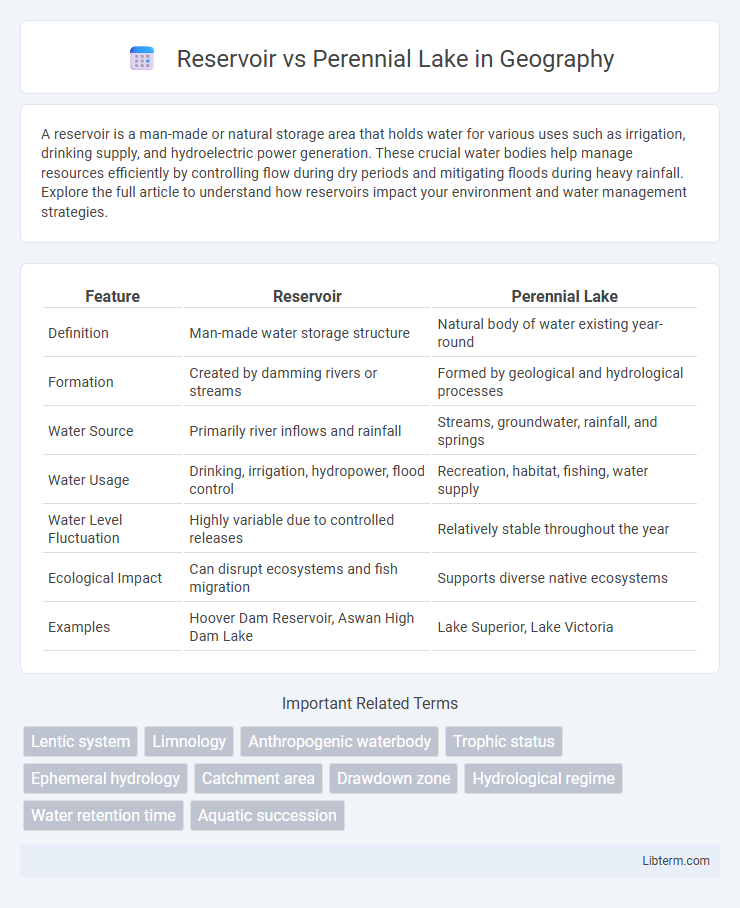A reservoir is a man-made or natural storage area that holds water for various uses such as irrigation, drinking supply, and hydroelectric power generation. These crucial water bodies help manage resources efficiently by controlling flow during dry periods and mitigating floods during heavy rainfall. Explore the full article to understand how reservoirs impact your environment and water management strategies.
Table of Comparison
| Feature | Reservoir | Perennial Lake |
|---|---|---|
| Definition | Man-made water storage structure | Natural body of water existing year-round |
| Formation | Created by damming rivers or streams | Formed by geological and hydrological processes |
| Water Source | Primarily river inflows and rainfall | Streams, groundwater, rainfall, and springs |
| Water Usage | Drinking, irrigation, hydropower, flood control | Recreation, habitat, fishing, water supply |
| Water Level Fluctuation | Highly variable due to controlled releases | Relatively stable throughout the year |
| Ecological Impact | Can disrupt ecosystems and fish migration | Supports diverse native ecosystems |
| Examples | Hoover Dam Reservoir, Aswan High Dam Lake | Lake Superior, Lake Victoria |
Introduction to Reservoirs and Perennial Lakes
Reservoirs are artificial or man-made lakes primarily created for water storage, flood control, irrigation, and hydroelectric power generation, often regulated by dams. Perennial lakes are natural water bodies that maintain water throughout the year due to consistent inflow from rivers, precipitation, or groundwater, sustaining diverse ecosystems. Understanding the distinctions in water source, management, and ecological impact is essential for water resource planning and environmental conservation.
Defining Reservoirs: Purpose and Formation
Reservoirs are artificial or natural lakes primarily designed for water storage, flood control, irrigation, and hydroelectric power generation. Unlike perennial lakes, which maintain consistent water levels year-round due to natural hydrological cycles, reservoirs are often created by damming rivers or streams to regulate water supply based on human needs. Their formation involves engineering interventions that control inflow and outflow, optimizing water availability for agricultural, municipal, and industrial uses.
Understanding Perennial Lakes: Natural Origins
Perennial lakes are naturally occurring bodies of water sustained by consistent inflows from rivers, precipitation, and groundwater, maintaining water levels year-round. Unlike reservoirs, which are artificial and created primarily for water storage, recreation, or hydroelectric power, perennial lakes often support diverse ecosystems due to their stable hydrological conditions. Understanding the natural origins of perennial lakes helps in managing their ecological balance and preserving biodiversity.
Key Differences in Water Management
Reservoirs are man-made structures designed for controlled water storage, flood control, and irrigation, whereas perennial lakes are natural bodies of water with stable year-round water levels influenced by climatic conditions. Reservoir water levels fluctuate significantly due to human regulation for hydroelectric power, agricultural needs, and municipal supply, while perennial lakes maintain relatively consistent levels through natural inflows and outflows. Effective water management in reservoirs requires continuous monitoring and adjustment of release rates, contrasting with the passive, ecological balance governing perennial lake water management.
Ecological Impacts: Reservoirs vs Perennial Lakes
Reservoirs often cause significant ecological disruption by altering natural water flow, temperature, and sediment transport, which can negatively impact native aquatic species and downstream ecosystems. Perennial lakes, maintaining natural water cycles, generally support more stable and diverse habitats by providing consistent resources for flora and fauna throughout the year. The construction and management of reservoirs can lead to habitat fragmentation, reduced biodiversity, and changes in nutrient cycling compared to the relatively stable conditions found in perennial lakes.
Biodiversity Comparison
Reservoirs and perennial lakes both support diverse ecosystems, but reservoirs often exhibit fluctuating water levels that can challenge stable habitats, while perennial lakes maintain consistent aquatic environments promoting greater species richness. Studies reveal that perennial lakes typically host more endemic and specialized species due to stable hydrological conditions, whereas reservoirs might favor opportunistic and generalist species adapted to dynamic water regimes. The variation in nutrient cycling and sedimentation patterns between the two water bodies further influences the diversity and distribution of aquatic flora and fauna.
Human Uses and Benefits
Reservoirs provide controlled water storage for irrigation, hydroelectric power generation, and municipal water supply, offering significant benefits in managing seasonal water availability and supporting economic activities. Perennial lakes offer stable ecosystems that support recreational activities, fishing, and tourism throughout the year, contributing to local biodiversity and community well-being. Both water bodies play critical roles in flood control and groundwater recharge, but reservoirs are engineered primarily for human utility while perennial lakes naturally sustain environmental balance.
Water Quality Considerations
Reservoirs often experience variable water quality due to fluctuating water levels and inflows, which can lead to increased sedimentation, nutrient loading, and algal blooms. Perennial lakes maintain more stable water volumes and temperatures, generally supporting consistent dissolved oxygen levels and clearer water clarity. Managing reservoir water quality requires careful monitoring of inflow sources and retention times to mitigate eutrophication and contamination risks compared to naturally balanced perennial lakes.
Challenges and Environmental Concerns
Reservoirs often face challenges such as sedimentation, water quality degradation, and disrupted natural flow regimes, which can harm aquatic ecosystems and reduce storage capacity. Perennial lakes, while more stable in water levels, encounter issues like eutrophication, invasive species, and pollution from surrounding land use, impacting biodiversity and water quality. Both water bodies require careful management to balance human demands and environmental health, with emphasis on sustainable water resource planning and habitat conservation.
Choosing Between Reservoirs and Perennial Lakes
Choosing between reservoirs and perennial lakes depends on water management goals and ecological impact. Reservoirs offer controlled water storage and supply for irrigation, hydroelectric power, and flood control, while perennial lakes provide stable, natural habitats with consistent water levels supporting biodiversity and recreational activities. Assessing factors such as water demand fluctuations, environmental preservation, and local climate is crucial for effective decision-making.
Reservoir Infographic

 libterm.com
libterm.com